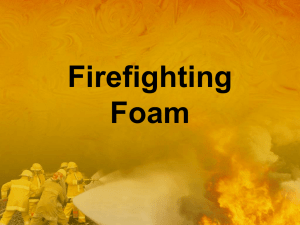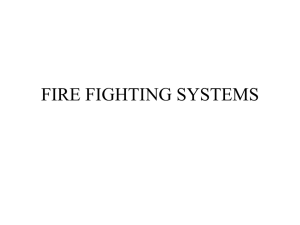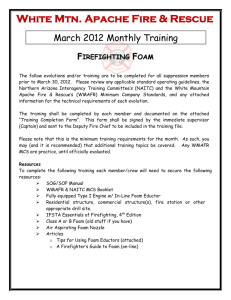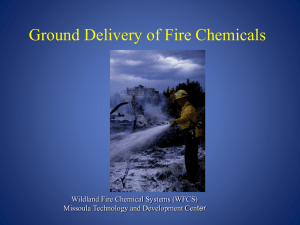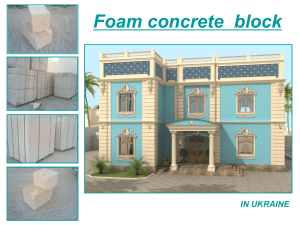What is Foam?
advertisement
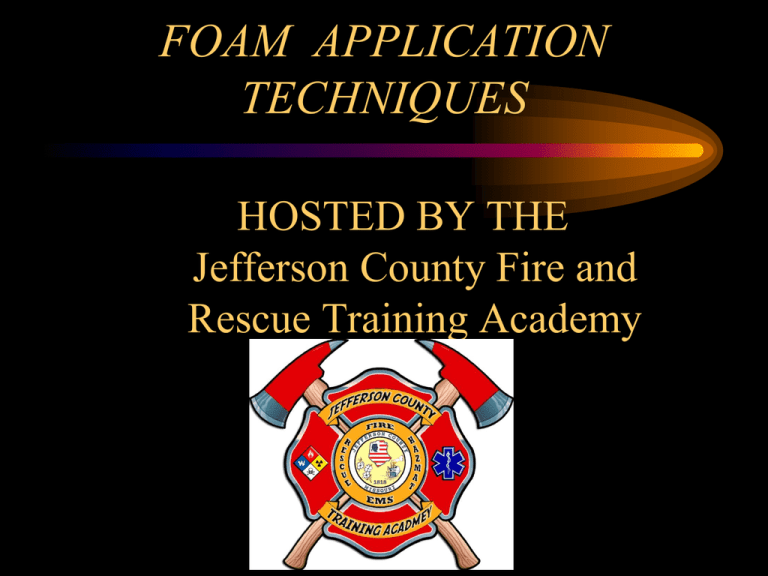
FOAM APPLICATION TECHNIQUES HOSTED BY THE Jefferson County Fire and Rescue Training Academy TACTICS • DO NOT START A FOAM OPERATION IF YOU DO NOT HAVE ENOUGH FOAM. (The fire will not go out and you will just waist foam) • *INSTEAD, ATTEMPT TO PROTECT EXPOSURES OR EVACUATE • IF YOU HAVE AN ETHANOL FIRE, USE ARFOAM • IF AT A FIXED FACILITY, ASK THE PEOPLE THAT WORK THERE FOR HELP. (They are the experts with the product on fire.) OBJECTIVES • • • • • • • TERMS HOW FOAM WORKS FOAM GENERATION TYPES OF FOAM APPLICATION RATES FOAM EQUIPMENT PRACTICAL EVOLUTION What is Foam? • NFPA- 11 describes Foam as an aggregate of air filled bubbles and is lower in density than flammable liquids. • Must be able to– – – – – Flow Freely Have a high resistance to heat Fuel tolerance Form a tough, cohesive blanket Must hold water Foam’s Extinguishing Characteristics Smothering: prevents release of vapors Separating: creates a barrier between the fuel and fire Cooling: lowers temperature of the fuel Limitations of Foam • Foam solution is 94%-97% water – Cannot be used on: • Electrical fires • Three Dimensional Fires • Pressurized Gases • Combustible Metals Kinds of Foam • • • • • Protein Fluroprotein Film Forming Protein (FFFP) Aqueous Film Forming Foam (AFFF) Alcohol Resistant AFFF (ARFFF) Aqueous Film Forming Foam (AFFF) • Good penetrating characteristics • Can be used with non-aerating nozzles • Spreads a vapor-sealing film over fuels • Can be pre-mixed • Can be mixed with antifreeze • Good low temperature viscosity May be applied directly on fuel surface, applied indirectly, or used with subsurface injection Foam Delivery Systems • • • • In-Line Eductors Around the Pump Eductor Compressed Air Foam System By-Pass Line Eductor In-line Foam Eductors Most commonly used Attached to pump or at some point in the hose lay The foam concentrate inlet to the inductor must be no more than six feet above the surface of the liquid foam concentrate Venturi Principle in Eductors As water at a high pressure passes over a reduced opening, it creates a low pressure near the outlet side of the eductor The low pressure creates a suction which draws the foam concentrate into the water stream. REMEMBER • MATCH NOZZLE TO EDUCTOR • MAINTAIN 200 PSI INLET PRESSURE HYDRAULICS Back Pressure should not exceed 70% of inlet pressure • Back Pressure=NP+FLH+FLE 250’ of 1.75” and 0’ elevation – FLH= 100 + 30psi + 0= 130 psi – FLE= 70 psi • 130psi + 70 psi= 200 psi Foam Production • Foam must be proportioned with water and aerated with air to be used effectively • Most fire fighting foams are designed to be mixed at 3% to 6% concentrate in water Foam & Foam Streams To be effective, foam concentrates must be matched to the fuel to which they are applied DETERMINE TYPE OF LIQUID • POLAR SOLVENTS- .16 GPM SQ. FT. • HYDROCARBONS - .10 GPM SQ. FT. HOW MUCH FOAM - NFPA 11 1. DETERMINE SQUARE FOOTAGE 10 FT. X 1OO FT.= 1000 SQ. FT. 2. DETERMINE TYPE OF LIQUID POLAR SOLVENT- .16 GPM/SQ. FT. HYDROCARBONS- .10 GPM/SQ.FT. APPLICATION RATES hydrocarbon fuels 3. 4. DETERMINE AMOUNT OF FOAM CONCENTRATE. 100 GPM X .O3 = 3 Gal. Foam/Min. AMOUNT REQUIRED FOR 15 MIN. 3 GPM X 15 MIN. = 45. Gal of Foam will be required. APPLICATION RATES hydrocarbon fuels 5. Determine amount of water needed 100 GPM X .97 = 97 GPM 97 X 15 = 1455 Gallons of Water Foam Application Methods • Roll – On Method • Bank Down Technique • Rain – Down Method FOAM APPLICATION • • • • • SCBA SWEEPING MOTION DO NOT PLUNGE FOAM DO NOT WALK IN LIQUID DO NOT TURN YOUR BACK TO FLAMMABLE • DO PRESERVE THE FOAM BLANKET Causes of Poor Foam Generation • Eductor and Nozzle Mismatch • Too Much Hose between Eductor & Nozzle • Nozzle Elevation • Partially closed Nozzle Shut Off • Kinked Discharge Line • Fuel Mixture comprised of 85% ethanol and 15 % gasoline • Fires should be treated differently than traditional gasoline fires– These mixtures are polar/water-miscible flammable liquids ( ie- they mix readily with water) – Degrade effectiveness of fire-fighting foam which is not alcohol- resistant • Refer to Guide 127 ( Flammable Liquids Polar/Water Miscible) of 2004 ERG PRACTICAL • HOOK-UP EDUCTOR • MAKE SURE NOZZLE MATCHES EDUCTOR • SET METERING DEVICE • SET FLOWING PRESSURE • INSERT PICK-UP TUBE INTO FOAM QUESTIONS? DETERMINE AMOUNT OF FOAM CONCENTRATE 600 GPM X .03 = 18 GAL. FOAM MIN. Fluoroprotein Foam Good water-retention capabilities Excellent heat resistance Not affected by freezing & thawing Can be mixed with antifreeze Good fluidity on fuel surface Protein Foam Excellent water-retention capabilities High heat resistance and re-ignition resistance Performance can be affected by freezing and thawing Can be mixed with antifreeze Can be made resistant to alcohol Do not allow foam to plunge into burning liquids.
